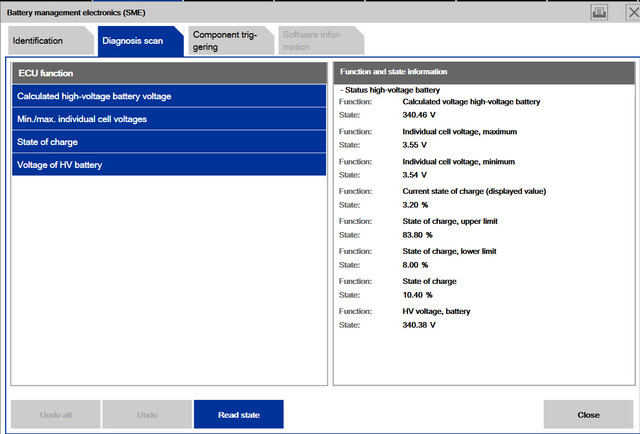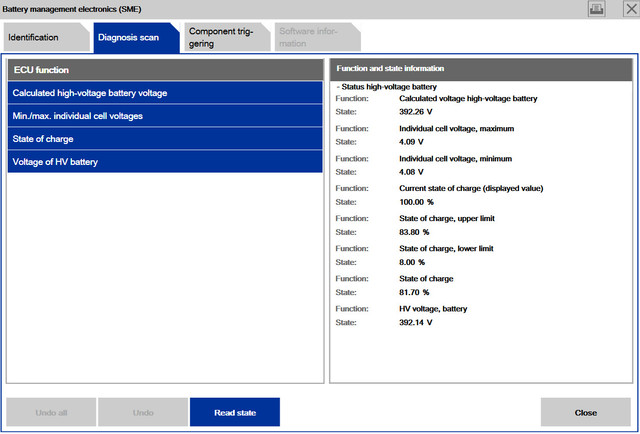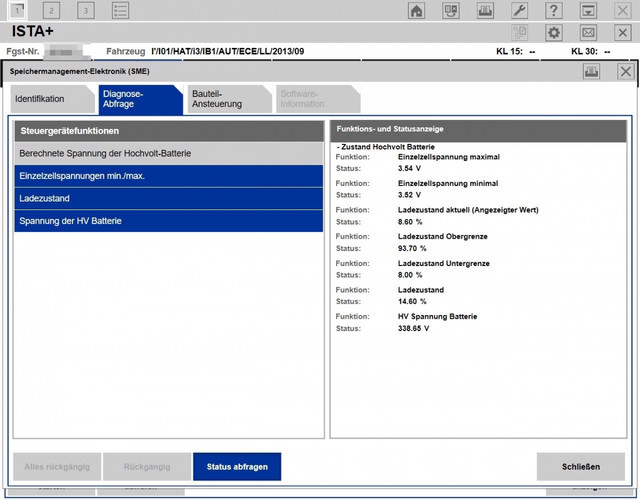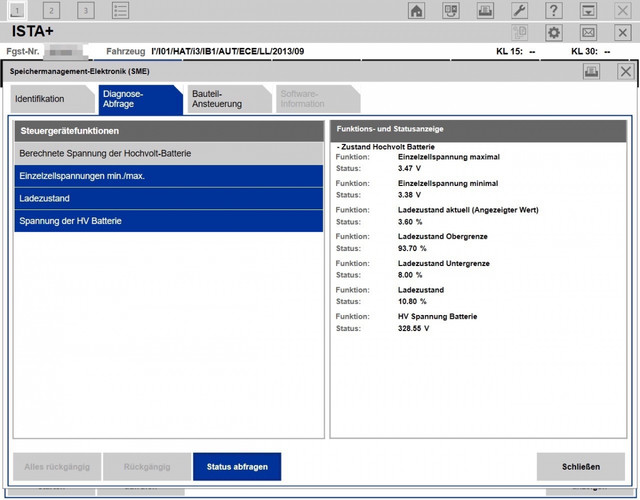Oleksiy
Well-known member
I checked my logs during the extended weekend we had in Ukraine, and it appeared that my last 100% charge took place back in March. And also, I had only five full 100% charges during March as well, with average beginning of day SOC staying at 85% both for March and April. This looked like a perfect opportunity to see some out-of-balance cells.
First thing I tried was to deplete the battery closer to zero (the cell balancing situation should deteriorate at lower SOC), but managed to do this via climate settings only down to 3%. After that the system said "Independent ventilation deactivated", and that was it. I din't feel comfortable driving around lest the car died far away from the charging station.
The result was as follows:

So, I have 3.54-3.55 cell voltage range, cells seem to be in good balance at 3.2% SOC. But other indicators look like a total mess. The upper SOC limit is at 83.8%, the lower - at 8% - both normal and matching 16.5 kWh remaining battery capacity according to Batt.Kapa. What looks suspicious is the cell voltage itself, and the battery voltage as well. Comparing 3.55V cell / 340V battery with the perfectly healthy pack here (albeit at 0% SOC with out of balance cells) https://okedv.dyndns.org/wbb/wcf/index.php?attachment/1985-pasted-from-clipboard-png/ (taken from the page with instructions https://okedv.dyndns.org/wbb/blog/index.php?entry/86-bmw-i-series-hochvolt-batterie-spannungen-auslesen/), the voltages look way too high for 3% SOC.
I than charged my car overnight, leaving it at 100% SOC for about 6 hours in an attempt to balance the cells properly. The 100% output looks like this:

Upper and lower SOC limits remain the same, real SOC is at 81.7% vs. 100% SOC displayed. But cell and battery voltage (4.09 and 392V seem to match those of the healthy battery at 100% SOC (91% actual SOC) here https://okedv.dyndns.org/wbb/wcf/index.php?attachment/1984-pasted-from-clipboard-png/.
Provided that I could trust these readings at all, my conclusions are as follows:
(1) Cell balancing does not necessarily occur at 100% only. Or they are well balanced on their own despite charging to lower than 100% for many weeks in a row.
(2) Lower SOC limit seems to be fixed at 8% for all packs regardless of the degradation (I checked many similar screenshot examples taken from different cars on the web).
(3) Upper SOC limit doesn't seem to represent the real SOC limit since the pack's voltage is the same for both 82% and 91% actual SOC (100% displayed SOC).
(4) Most likely, upper SOC limit is unchanged regardless of the degradation level, but the BMS just limits the discharge capacity of the pack by voltage, hence effectively increasing the bottom SOC limit.
Still, 3.55 cell voltage for 3.2% displayed SOC seems way too high for my case. Taking the healthy battery example under the links above as a base, and provided the voltage drop vs. SOC is linear, and also given the 12% degradation of my pack, the cell voltage should be at 3.17V, not at 3.55V. Or I'm wrong in my understanding / calculations.
Please let me know your thoughts. Any real life examples of your own?
First thing I tried was to deplete the battery closer to zero (the cell balancing situation should deteriorate at lower SOC), but managed to do this via climate settings only down to 3%. After that the system said "Independent ventilation deactivated", and that was it. I din't feel comfortable driving around lest the car died far away from the charging station.
The result was as follows:

So, I have 3.54-3.55 cell voltage range, cells seem to be in good balance at 3.2% SOC. But other indicators look like a total mess. The upper SOC limit is at 83.8%, the lower - at 8% - both normal and matching 16.5 kWh remaining battery capacity according to Batt.Kapa. What looks suspicious is the cell voltage itself, and the battery voltage as well. Comparing 3.55V cell / 340V battery with the perfectly healthy pack here (albeit at 0% SOC with out of balance cells) https://okedv.dyndns.org/wbb/wcf/index.php?attachment/1985-pasted-from-clipboard-png/ (taken from the page with instructions https://okedv.dyndns.org/wbb/blog/index.php?entry/86-bmw-i-series-hochvolt-batterie-spannungen-auslesen/), the voltages look way too high for 3% SOC.
I than charged my car overnight, leaving it at 100% SOC for about 6 hours in an attempt to balance the cells properly. The 100% output looks like this:

Upper and lower SOC limits remain the same, real SOC is at 81.7% vs. 100% SOC displayed. But cell and battery voltage (4.09 and 392V seem to match those of the healthy battery at 100% SOC (91% actual SOC) here https://okedv.dyndns.org/wbb/wcf/index.php?attachment/1984-pasted-from-clipboard-png/.
Provided that I could trust these readings at all, my conclusions are as follows:
(1) Cell balancing does not necessarily occur at 100% only. Or they are well balanced on their own despite charging to lower than 100% for many weeks in a row.
(2) Lower SOC limit seems to be fixed at 8% for all packs regardless of the degradation (I checked many similar screenshot examples taken from different cars on the web).
(3) Upper SOC limit doesn't seem to represent the real SOC limit since the pack's voltage is the same for both 82% and 91% actual SOC (100% displayed SOC).
(4) Most likely, upper SOC limit is unchanged regardless of the degradation level, but the BMS just limits the discharge capacity of the pack by voltage, hence effectively increasing the bottom SOC limit.
Still, 3.55 cell voltage for 3.2% displayed SOC seems way too high for my case. Taking the healthy battery example under the links above as a base, and provided the voltage drop vs. SOC is linear, and also given the 12% degradation of my pack, the cell voltage should be at 3.17V, not at 3.55V. Or I'm wrong in my understanding / calculations.
Please let me know your thoughts. Any real life examples of your own?













































![Electric Spin Scrubber, [IPX7 Waterproof ] [50KG Torque] Shower Scrubber with 9 Brush Heads, 2 Speed Mode, 4 Adjustable Angles, Electric Brush for Cleaning for Bathroom Floor Tile (Gray)](https://m.media-amazon.com/images/I/51R1fR54smL._SL500_.jpg)






